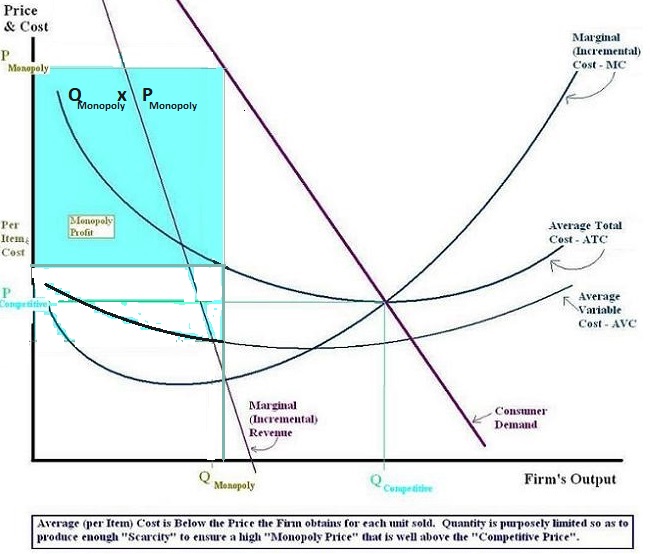Markup rule on:
[Wikipedia]
[Google]
[Amazon]
A markup rule is the pricing practice of a producer with
 :
By definition is the reciprocal of the
:
By definition is the reciprocal of the
market power
In economics, market power refers to the ability of a theory of the firm, firm to influence the price at which it sells a product or service by manipulating either the supply or demand of the product or service to increase economic profit. In othe ...
, where a firm charges a fixed mark-up over its marginal cost
In economics, the marginal cost is the change in the total cost that arises when the quantity produced is increased, i.e. the cost of producing additional quantity. In some contexts, it refers to an increment of one unit of output, and in others it ...
.Roger LeRoy Miller, ''Intermediate Microeconomics Theory Issues Applications, Third Edition'', New York: McGraw-Hill, Inc, 1982.Tirole, Jean, "The Theory of Industrial Organization", Cambridge, Massachusetts: The MIT Press, 1988.
Derivation of the markup rule
Mathematically, the markup rule can be derived for a firm with price-setting power by maximizing the following expression forprofit
Profit may refer to:
Business and law
* Profit (accounting), the difference between the purchase price and the costs of bringing to market
* Profit (economics), normal profit and economic profit
* Profit (real property), a nonpossessory inter ...
:
:
:where
:Q = quantity sold,
:P(Q) = inverse demand function, and thereby the price at which Q can be sold given the existing demand
In economics, demand is the quantity of a goods, good that consumers are willing and able to purchase at various prices during a given time. In economics "demand" for a commodity is not the same thing as "desire" for it. It refers to both the desi ...
:C(Q) = total cost
In economics, total cost (TC) is the minimum financial cost of producing some quantity of output. This is the total economic cost of production and is made up of variable cost, which varies according to the quantity of a good produced and includ ...
of producing Q.
: = economic profit
Profit maximization
In economics, profit maximization is the short run or long run process by which a firm may determine the price, input and output levels that will lead to the highest possible total profit (or just profit in short). In neoclassical economics, ...
means that the derivative of with respect to Q is set equal to 0:
:
: where
:P'(Q) = the derivative
In mathematics, the derivative is a fundamental tool that quantifies the sensitivity to change of a function's output with respect to its input. The derivative of a function of a single variable at a chosen input value, when it exists, is t ...
of the inverse demand function.
:C'(Q) = marginal cost–the derivative of total cost
In economics, total cost (TC) is the minimum financial cost of producing some quantity of output. This is the total economic cost of production and is made up of variable cost, which varies according to the quantity of a good produced and includ ...
with respect to output.
This yields:
:
or " marginal revenue" = "marginal cost
In economics, the marginal cost is the change in the total cost that arises when the quantity produced is increased, i.e. the cost of producing additional quantity. In some contexts, it refers to an increment of one unit of output, and in others it ...
".
price elasticity of demand
A good's price elasticity of demand (E_d, PED) is a measure of how sensitive the quantity demanded is to its price. When the price rises, quantity demanded falls for almost any good ( law of demand), but it falls more for some than for others. Th ...
(or ). Hence
:
Letting be the reciprocal of the price elasticity of demand
A good's price elasticity of demand (E_d, PED) is a measure of how sensitive the quantity demanded is to its price. When the price rises, quantity demanded falls for almost any good ( law of demand), but it falls more for some than for others. Th ...
,
:
Thus a firm with market power chooses the output quantity at which the corresponding price satisfies this rule. Since for a price-setting firm this means that a firm with market power will charge a price above marginal cost and thus earn a monopoly rent. On the other hand, a competitive firm by definition faces a perfectly elastic demand; hence it has which means that it sets the quantity such that marginal cost equals the price.
The rule also implies that, absent menu costs, a firm with market power will never choose a point on the inelastic portion of its demand curve (where and ). Intuitively, this is because starting from such a point, a reduction in quantity and the associated increase in price along the demand curve would yield both an increase in revenues (because demand is inelastic at the starting point) and a decrease in costs (because output has decreased); thus the original point was not profit-maximizing.
References
{{reflist Pricing